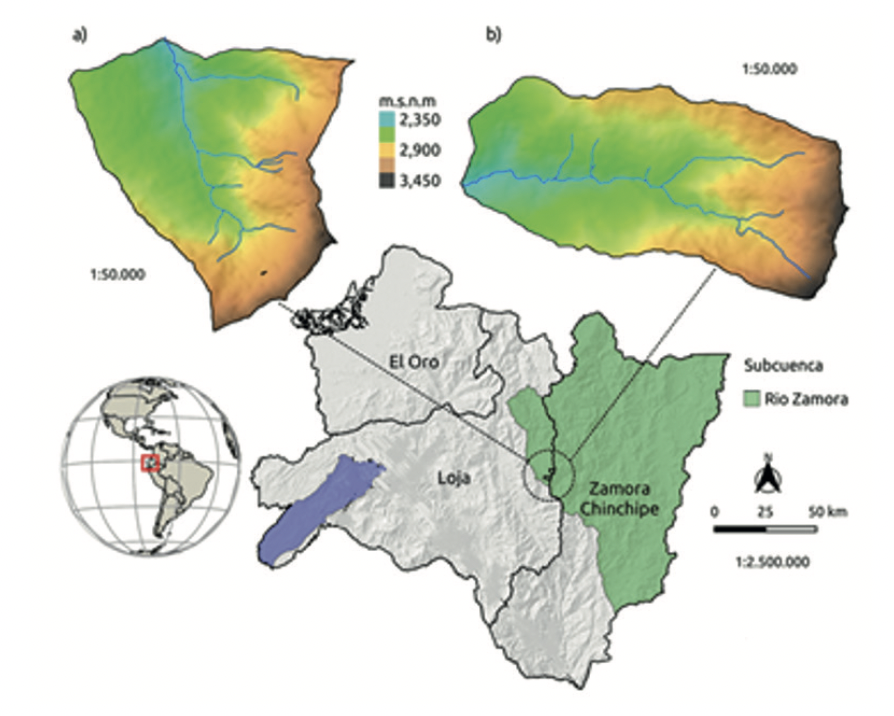Vulnerabilidad al cambio climático en microcuencas de alta montaña abastecedoras de agua en la Región Sur del Ecuador
Palabras clave:
vulnerabilidad al cambio climático, exposición climática, capacidad adaptativa, Andes.Resumen
En las últimas décadas se ha observado una fuerte influencia de las actividades antrópicas sobre microcuencas que proveen el servicio ecosistémico hídrico. A eso se suman los posibles impactos del cambio climático relacionados a variaciones extremas en temperatura y precipitación que podrían generar una alta vulnerabilidad dentro de las microcuencas y servicios ecosistémicos primordiales para el desarrollo de las comunidades. El presente estudio analiza cuál podría ser el grado de vulnerabilidad de dos microcuencas de alta montaña de importancia hídrica en la Región Sur de Ecuador. Para el análisis de vulnerabilidad se consideró la exposición, sensibilidad y la capacidad adaptativa. Los resultados muestran que las microcuencas El Carmen CA (cabecera de agua) y Mónica en el Cantón Loja podrían tener una vulnerabilidad moderada a alta bajo escenarios pesimistas (RCP 8,5). En lo concerniente a la capacidad adaptativa, se observó que El Carmen y Mónica poseen niveles de capacidad adaptativa altos. Estos resultados están relacionados a la presencia de estrategias de conservación en dichas microcuencas y muestran la importancia de generar acciones de conservación y restauración a nivel de paisaje, que permitan el mantenimiento y recuperación de ecosistemas que proveen el servicio ecosistémico hídrico, de esta manera también se podría asegurar la calidad y cantidad de agua para las comunidades.Citas
Anderson, E., Marengo, J., Villalba, R., Halloy, S., Young, B., Cordero, D., & Ruiz, D. (2011). Consequences of climate change for ecosystems and ecosystem services in the tropical Andes. In S. Herzog, R. Martinez, P. Jorgensen, & H. Tiessen (Eds.), Climate change and biodiversity in tropical Andes. MacArthur Foundation, Inter-American Institute for Global Change Research (IAI), Scientific Committee on Problems of the Environment (SCOPE) (pp. 1–5).
Brewer, C., & Pickle, L. (2002). Evaluation of Methods for Classifying Epidemiological Data on Choropleth Maps in Series. Annals of the Association of American Geographers, 92(4), 662–681.
Buytaert, W., Célleri, R., De-Bièvre, B., Cisneros, F., Wyseure, G., Deckers, J., & Hofstede, R. (2006). Human impact on the hydrology of the Andean páramos. Earth-Science Reviews, 79, 53 – 72.
Buytaert, W., Cuesta-Camacho, F., & Tobón, C. (2011). Potential impacts of climate change on the environmental services of humid tropical alpine regions. Global Ecology and Biogeography, 20, 19 – 33.
Cinner, J., McClanahan, T., Graham, N., Daw, T. M., Maina, J., Stead, S., Wamukota, A., Brown, K., & Bodin, O. (2012). Vulnerability of coastal communities to key impacts of climate change on coral reef fisheries. Global Environmental Change, 22(1), 12–20. https://doi.org/10.1016/j.gloenvcha.2011.09.018
Colwell, R., Brehm, G., Cardelús, C., Gilman, A., & Longino, J. (2009). Global Warming, Elevational Range Shifts, and Lowland Biotic Attrition in the Wet Tropics. Science, 322, 258–261.
Dore, M. H. I. (2005). Climate change and changes in global precipitation patterns: What do we know? Environment International, 31(8), 1167–1181. https://doi.org/10.1016/j.envint.2005.03.004
Eigenbrod, F., Gonzalez, P., Dash, J., & Steyl, I. (2015). Vulnerability of ecosystems to climate change moderated by habitat intactness. Global Change Biology, 21(1), 275–286. https://doi.org/10.1111/gcb.12669
Foster, P. (2001). The potential negative impacts of global climate change on tropical montane cloud forests. Earth-Science Reviews, 55, 73-106 p.
Furniss, M., Staab, B., Hazelhurst, S., Clifton, C., Roby, K., Ilhadrt, B., Larry, E., Todd, A., Reid, L., Hines, S., Bennett, K., Luce, C., & Edwards, P. (2010). Water, climate change, and forests: Watershed stewardship for a changing climate. In General Technical Report PNW-GTR812.
Füssel, H.-M. (2010). Review and quantitative analysis of indices of climate change exposure, adaptive capacity, sensitivity, and impacts. World Development Report, 34. https://doi.org/10.1016/j.gloenvcha.2010.07.009
Fussel, H.-M., & Klein, R. (2007). Climate change vulnerability assessments: an evolution of conceptual thinking. Climate Change, 75, 301–329.
INEC. (2010). Censo de población y vivienda. Instituto Nacional de Estadísticas y Censos.
IPCC. (2001). Cambio climático 2001. Impactos, adaptación y vulnerabilidad. Parte de la contribución del Grupo de trabajo II al Tercer Informe de Evaluación Grupo Intergubernamental de Expertos sobre el Cambio Climático. Grupo Intergubernamental de Expertos sobre el Cambio Climático.
IPCC. (2007). Climate Change 2007: The Physical Science Basis. Cambridge University Press, Cambridge. Intergovernmental Panel on Climate Change.
IPCC. (2013). IPCC 5th Assessment Report “Climate Change 2013: The Physical Science Basis.”
IPCC. (2014). Summary for policymakers. In: Climate Change 2014: Impacts, Adaptation, and Vulnerability. Part A: Global and Sectoral Aspects. Contribution of Working Group II to the Fifth Assessment Report of the Intergovernmental Panel on Climate Change (C. B. Field, V. R. Barros, D. J. . Dokken, K. J. . Mach, M. D. . Mastrandrea, T. E. . Bilir, M. Chatterjee, K. L. . Ebi, Y. O. . Estrada, R. C. . Genova, B. Girma, E. S. . Kissel, A. N. . Levy, S. MacCracken, & and L. L. W. P.R. Mastrandrea (eds.)).
IPCC. (2022). Climate change 2022: impacts, adaptation and vulnerability (A. H.-O. Pörtner, D.C. Roberts, E.S. Poloczanska, K. Mintenbeck, M. Tignor & A. O. (eds) Alegría, M. Craig, S. Langsdorf, S. Löschke, V. Möller (eds.)). IPCC.
Kimble, J. M., & Stewart, B. A. (2019). Global climate change and tropical ecosystems. Routledge.
Liu, X., Wang, Y., Peng, J., Braimoh, A., & Yin, H. (2013). Assessing vulnerability to drought based on exposure, sensitivity and adaptive capacity: A case study in middle Inner Mongolia of China. Chinese Geographical Science, 23(1), 13–25. https://doi.org/10.1007/s11769-012-0583-4
Lozano, P. (2002). Los tipos de bosque del sur del Ecuador. In Z. Aguirre, M. Madsen, E. Cotton, & H. Balslev (Eds.), Botánica Austroecuatoriana: Estudios sobre los recursos vegetales en las provincias de El Oro, Loja y Zamora- Chinchipe (pp. 29–49).
MAE. (2013). Metodología para la Representación Cartográfica de los Ecosistemas del Ecuador Continental. Subsecretaría de Patrimonio Natural. Ministerio del Ambiente del Ecuador. Quito. 121.
Marshall, E., & Randhir, T. (2008). Effect of climate change on watershed system: a regional analysis. Climatic Change, 89, 263–280.
MEA. (2005). Millennium Ecosystem Assessment. Ecosystems and Human Well-being: Synthesis. Millennium Ecosystem Assessment. Island Press.
Mejía-Veintimilla, D., Ochoa-Cueva, P., Samaniego-Rojas, N., Félix, R., Arteaga, J., Crespo, P., Oñate-Valdivieso, F., & Fries, A. (2019). River discharge simulation in the high andes of southern ecuador using high-resolution radar observations and meteorological station data. Remote Sensing, 11(23), 2804.
Ochoa-Tocachi, B. F., Buytaert, W., De Bièvre, B., & Célleri, R. (2016). Impacts of land use on the hydrological response of tropical Andean catchments. Hydrological Processes, 30, 4074–4089. https://doi.org/10.1002/hyp.10980
PNUD, Municipio de Loja, & NCI. (2007). Perpectivas del Medio Ambiente Urbano: GEO Loja.
Pohle, P., & Gerique, A. (2008). Sustainable and Non-Sustainable use of natural resources by indigenous and local communities. In Gradients in a tropical mountain ecosystem of Ecuador (pp. 331–345).
Saaty, T. (1990). How to make a decision : The Analytic Hierarchy Process. European Journal of Operational Research, 48, 9–26.
Saaty, T. (2008). Decision making with the analytic hierarchy process Thomas L. Saaty. International Journal of Services Sciences, 1(1), 83–98.
Sklenář, P., Romoleroux, K., Muriel, P., Jaramillo, R., Bernardi, A., Diazgranados, M., & Moret, P. (2021). Distribution changes in páramo plants from the equatorial high Andes in response to increasing temperature and humidity variation since 1880. Alpine Botany, 131(2), 201–212.
TNC. (2010). Vulnerabilidad y cambio climático en Ecuador: Síntesis de información existente recomendaciones.
Valencia, J. B., Mesa, J., León, J. G., Madriñán, S., & Cortés, A. J. (2020). Climate vulnerability assessment of the espeletia complex on Páramo Sky Islands in the Northern Andes. Frontiers in Ecology and Evolution, 309.
Vuille, M., Francou, B., Wagnon, P., Juen, I., Kaser, G., Mark, B. G., & Bradley, R. S. (2008). Climate change and tropical Andean glaciers: Past, present and future. Earth-Science Reviews, 89(3–4), 79–96. https://doi.org/10.1016/j.earscirev.2008.04.002
World Meteorological Organization (WMO). (2021). State of the Climate in Latin America and the Caribbean.
Young, B., Young, K., & Josse, C. (2011). Vulnerability of Tropical Andean Ecosystems to Climate Change. In Climate change and biodiversity in tropical Andes. MacArthur Foundation, Inter-American Institute for Global Change Research (IAI), Scientific Committee on Problems of the Environment (SCOPE) (pp. 170–181).
Zarate, C. (2011). Hacia un modelo de ordenación. Para los territorios de protección natural del área de influencia inmediata de la ciudad de LOja. Microcuenca el Carmen. Universidad Estatal de Cuenca.

Publicado
Cómo citar
Número
Sección
Licencia
Derechos de autor 2022 Bosques Latitud Cero

Esta obra está bajo una licencia internacional Creative Commons Atribución-NoComercial-CompartirIgual 4.0.
Esta obra se publica bajo la licencia Creative Commons Atribución-NoComercial-CompartirIgual 4.0 Internacional (CC BY-NC-SA 4.0). Esto significa que los usuarios pueden copiar, distribuir y adaptar el contenido, siempre que se otorgue el crédito adecuado a los autores y a la revista. No se permite el uso comercial del material. Además, cualquier obra derivada debe distribuirse bajo la misma licencia. Esta licencia garantiza el acceso abierto al conocimiento, promoviendo la difusión y reutilización de los trabajos publicados sin fines de lucro, respetando la autoría y asegurando la libre circulación del contenido en términos equitativos.





























